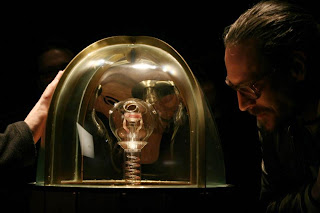 |
| The "man-made" neural network in a petri dish. |
 |
| Stelios Arcadious and his third ear. |
However, it is interesting that something that seemed so frivolous was actually used for a woman who lost her left ear, and was able to regrow it under her forearm (Jennings). The video below briefly explains the woman's situation.
I think that scientists who manipulate cells and genes should be given more leniency than artists who do this. For example, a rabbit's genetic code was modified so that it would glow in the dark (The Guardian). This was done for medical reasons so that the scientists can test the success of altering an animal's genetic code. This has potential for many other medical applications. However, this has also been done by a man named Eduardo Kac purely for artistic reasons ("GFP Bunny"), and I think that this is unethical. It was highly possible for the bunny to experience negative side effects from genetic alteration, and there were not any positive benefits to performing this experiment. I think using life science as a medium for art is fine, but when it is possible to endanger animals without there being any medical benefits to the experiment, then I don't think the endeavour should be performed.
 |
| Alba, the glow in the dark bunny. |
References
"SymbioticA." Semipermeable (+). The University of Western Australia, 2012. Web. 10 May 2015.
"Artist Implants 'third Ear' on His Own Arm." Mail Online. Associated Newspapers, 10 Oct. 2007. Web. 10 May 2015.
Jennings, Ashley. "Doctors Grow New Ear on Cancer Victim's Arm." ABC News. ABC News Network, 29 Sept. 2012. Web. 10 May 2015.
"Scientists Breed Glow-in-the-Dark Rabbits." The Guardian. The Guardian, 13 Aug. 2013. Web. 10 May 2015.
"GFP Bunny." Kac Web. Web. 10 May 2015.
No comments:
Post a Comment